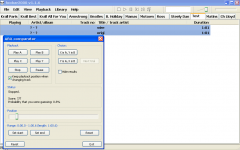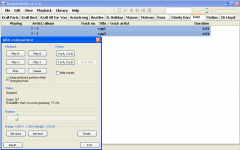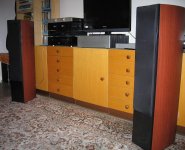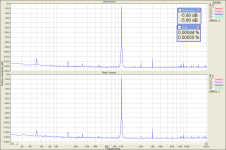Sorry, Pavel, turned out to be a 'medical' day yesterday, first chance this morning to listen, thanks for the posting!
Straightaway, speakers and DAC dead cold, in worst listening state, orig was so superior, way in front of cap2. The giveaway, the quality of the cymbals, in the 2nd half of the snippet - in orig this was the first time the tone of these actually worked as reminding me of the real thing, even though the playback was relatively poor. Going across to cap2 and wire, yes, the cymbals were there, but they were relatively anonymous, the sparkle of the real thing was severely curtailed, in comparison.
Straightaway, speakers and DAC dead cold, in worst listening state, orig was so superior, way in front of cap2. The giveaway, the quality of the cymbals, in the 2nd half of the snippet - in orig this was the first time the tone of these actually worked as reminding me of the real thing, even though the playback was relatively poor. Going across to cap2 and wire, yes, the cymbals were there, but they were relatively anonymous, the sparkle of the real thing was severely curtailed, in comparison.
I get 7/7 ABX result when I compare the original sound file with D/A - wire- A/D sound file. Matched and aligned, of course. Listening in a second room through open door, sitting at my PC, the biggest difference is in the sound impact.
When doing cap1 x cap3 (Mundorf x Roederstein), I get 2/7 result, or something similarly random when repeated.
The conclusion, to me, is like this: there is a big difference after applying a commercial D/A - A/D chain to the original data. I would need something like Meitner system. Thus, even if there was a subtle audible sound difference between the caps, it would be very difficult to catch it, without having the best SOTA D/A A/D hardware available.
When doing cap1 x cap3 (Mundorf x Roederstein), I get 2/7 result, or something similarly random when repeated.
The conclusion, to me, is like this: there is a big difference after applying a commercial D/A - A/D chain to the original data. I would need something like Meitner system. Thus, even if there was a subtle audible sound difference between the caps, it would be very difficult to catch it, without having the best SOTA D/A A/D hardware available.
Attachments
Last edited:
The conclusion, to me, is like this: there is a big difference after applying a commercial D/A - A/D chain to the original data. I would need something like Meitner system. Thus, even if there was a subtle audible sound difference between the caps, it would be very difficult to catch it, without having the best SOTA D/A A/D hardware available.
Yes... but could it be argued also that each file, the original (off CD) and the A/D-D/A file can each be viewed as unique and valid.
Are you meaning that the extreme subtleties of for example, the inclusion of a cap in the A/D D/A chain would be non-detectable because the whole chains resolution is not high enough.
Is it possible I wonder to ABX two "identical" recordings made through the same A/D D/A process where the only difference is that they are two takes of the same recording.
There must be some "baseline" at which tests like these do become detectable to the listeners. Maybe that is worth exploring because if the "baseline" becomes so huge then it means the test process isn't working as intended. The trouble is that the software and the people skilled in using such software can seemingly pick the tiniest details from files and that has to sway the result. Sit them down and say "listen" and the results are probably much more blurred.
Hmmm... interesting.
Yes... but could it be argued also that each file, the original (off CD) and the A/D-D/A file can each be viewed as unique and valid.
Are you meaning that the extreme subtleties of for example, the inclusion of a cap in the A/D D/A chain would be non-detectable because the whole chains resolution is not high enough.
Is it possible I wonder to ABX two "identical" recordings made through the same A/D D/A process where the only difference is that they are two takes of the same recording.
Certainly. Cap1 and cap2 were two files recorded through same path. Their difference is a noise signal, maybe with some subtle sound modulations, and no one has posted any ABX result that would proof an audible difference. Only unsupported claims on clearly audible differences.
The whole chain error must be the smallest possible, to perform such tests like these are. If the original x D/A - A/D chain is reliably distinguishable, then the resolution to pick up audible differences between capacitors is insufficient, even if they existed. We can only say we did not found them under existing test conditions. We cannot say they do not exist.
Several rounds of D/A A/D re-recordings might help to reveal what is added or lost during this process.
Good idea. That could reveal something although again, software analysis always seems to reveal some difference when there are two files to compare.
Several rounds of D/A A/D re-recordings might help to reveal what is added or lost during this process.
We have repeatedly tested this, with positive results. Even here at diyaudio.
The whole chain error must be the smallest possible, to perform such tests like these are. If the original x D/A - A/D chain is reliably distinguishable, then the resolution to pick up audible differences between capacitors is insufficient, even if they existed. We can only say we did not found them under existing test conditions. We cannot say they do not exist.
This is the crucial part as I see it, and why trying to determine a baseline of what can or can not be detected audibly (and that is the important part) is perhaps important to any future tests. And listeners have to be confident to say which they actually prefer whether it be a cheap device under test or a SOTA device and not just say, yes there is a difference.
This is the crucial part as I see it, and why trying to determine a baseline of what can or can not be detected audibly
Yes, valid only and only under the test conditions used. No generalization is possible then.
In my system, A/D is the biggest issue. D/A is always the same and the difference between sound of D/A only and sound of D/A-A/D recorded file is reliably detectable.
Last edited:
The most common mistake by hobbiests lies in the assumption that any change will be shown in harmonic distortion tests. If any change is found to be under -70dB, it is unquestionably inaudible. What can account for a perceived change either in tonal balance or sonic signature, resides outside the scope of harmonic distortion. Is found instead within the domain of dynamic distortion.
100% true, but how to measure the dynamic distortions?
It is not a question of hobbyists only, I have never seen any professional method that would reliably and with high resolution measure something that we might call as transient spectrum of non-periodic, non-stationary signal. We all know FFT above single tone, two tones, multitone, noises, frequency/phase responses, impulse responses etc.
None of the measurement is able to provide us with a complex non-linear transfer function with respect to frequency, amplitude, load and input impedance. I would like to see it, once.
None of the measurement is able to provide us with a complex non-linear transfer function with respect to frequency, amplitude, load and input impedance. I would like to see it, once.
Thanks for original.wav.
Yes, caps alone are well modeled, along with resistors and inductors, such that when well employed behave accordingly under analysis. D/A, A/D, recording tape, vinyl recordings are much more difficult entities to model.
Dynamic distortion is good moniker for the multi-headed beast that enables discrimination of single element changes in audio systems.
Dynamic distortions may be categorized roughly in domains of: temporal, frequency, amplitude, and thermal. Simultaneous study is daunting.
Time and relativity. Time for fixed collection of objects viewed from fixed perspective does not exist. Perspective is pure thought, and thoughts require acceptance of existence. We have a very good thought model that can crush the universe into a singularity construct. The singularity is animated with the construction of a time axis. The universe is observed as point by point dilation across time axis.
Fast forward to 21st century Earth. Across the tiny dilation of time taken as our immediate existence, it is viewed as highly linear. Atomic clocks allow mapping of objects considered static from fixed perspective.
The conductor takes the podium. The score and his conception are in his head, stationary and fixed to the audience. There is no music. The conductor shares a common basis with the musicians. The conductor moves and time is created and radiated in a manner perceivable by the musicians. The conductor radiates his conception of the music. The conductor is the primary transducer. The musicians are the secondary transducers. With shared common basis with the conductor for the music, they produce sympathetic vibrations that are coupled to the final voicing transducers, which may be their own bodies, or the bodies of musical instruments. The phenomenon of sound in air is produced and radiates. The radiation encounters both fixed and active transducers, the favorites here being ears and microphones. All the active transducers have a time basis with dilation construct.
Mapping point by point along a dilated time basis is with points as energy amplitude. Energy construct may be substituted with thought, such as complete instances of the universe at moments in time.
Transformations of time and amplitude both held as linear and orthogonal yield the commonly used frequency domain representations.
Much of this depends upon perspective involving time and energy interaction as signal domain and principle of cause and effect of the radiation environment.
Time may be viewed as stationary with energy constant and moving across time. Energy encountering fixed objects along time line react to each object's time domain impedance characteristic. The energy distribution changes. Each new point of the distribution travels along its own time line, with all time lines superimposed upon each other. Mathematically this may be represented as the imaginary time plane or time vector space rooted to real time origin. In constrained physical system this may be seen as reflection, transmission, and radiation from a component in a system conducting time and energy. Radiation as heat may be seen as time vectors with energy points where superposition also holds reference to time origin.
I must take a break now, but leave off with a picture worth a thousand words. It contains information about original.wav, wire.wav, and superposition of a 1kHz.wav from a similar D/A A/D system. Later I will provide details of wire.wav and original.wav run on this similar D/A A/D system with fresh and proper referenced 1kHz.wav:
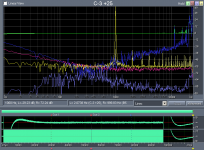
The above does involve other time transformations, and perspectives.
Yes, caps alone are well modeled, along with resistors and inductors, such that when well employed behave accordingly under analysis. D/A, A/D, recording tape, vinyl recordings are much more difficult entities to model.
Dynamic distortion is good moniker for the multi-headed beast that enables discrimination of single element changes in audio systems.
Dynamic distortions may be categorized roughly in domains of: temporal, frequency, amplitude, and thermal. Simultaneous study is daunting.
Time and relativity. Time for fixed collection of objects viewed from fixed perspective does not exist. Perspective is pure thought, and thoughts require acceptance of existence. We have a very good thought model that can crush the universe into a singularity construct. The singularity is animated with the construction of a time axis. The universe is observed as point by point dilation across time axis.
Fast forward to 21st century Earth. Across the tiny dilation of time taken as our immediate existence, it is viewed as highly linear. Atomic clocks allow mapping of objects considered static from fixed perspective.
The conductor takes the podium. The score and his conception are in his head, stationary and fixed to the audience. There is no music. The conductor shares a common basis with the musicians. The conductor moves and time is created and radiated in a manner perceivable by the musicians. The conductor radiates his conception of the music. The conductor is the primary transducer. The musicians are the secondary transducers. With shared common basis with the conductor for the music, they produce sympathetic vibrations that are coupled to the final voicing transducers, which may be their own bodies, or the bodies of musical instruments. The phenomenon of sound in air is produced and radiates. The radiation encounters both fixed and active transducers, the favorites here being ears and microphones. All the active transducers have a time basis with dilation construct.
Mapping point by point along a dilated time basis is with points as energy amplitude. Energy construct may be substituted with thought, such as complete instances of the universe at moments in time.
Transformations of time and amplitude both held as linear and orthogonal yield the commonly used frequency domain representations.
Much of this depends upon perspective involving time and energy interaction as signal domain and principle of cause and effect of the radiation environment.
Time may be viewed as stationary with energy constant and moving across time. Energy encountering fixed objects along time line react to each object's time domain impedance characteristic. The energy distribution changes. Each new point of the distribution travels along its own time line, with all time lines superimposed upon each other. Mathematically this may be represented as the imaginary time plane or time vector space rooted to real time origin. In constrained physical system this may be seen as reflection, transmission, and radiation from a component in a system conducting time and energy. Radiation as heat may be seen as time vectors with energy points where superposition also holds reference to time origin.
I must take a break now, but leave off with a picture worth a thousand words. It contains information about original.wav, wire.wav, and superposition of a 1kHz.wav from a similar D/A A/D system. Later I will provide details of wire.wav and original.wav run on this similar D/A A/D system with fresh and proper referenced 1kHz.wav:

The above does involve other time transformations, and perspectives.
Dynamic distortions may be categorized roughly in domains of: temporal, frequency, amplitude, and thermal. Simultaneous study is daunting.
Temporal and frequency are the same thing (or freely interconvertible). Ditto amplitude, which can be expressed in either the time or frequency domain interchangeably. Fourier Denial seems to be a strange mental pathology harbored by some.
The "simultaneous" requirement is odd- I can measure my car's speed, its length, and its weight. Why would I expect or even want to use a simultaneous single measurement to characterize all of them?
Time may be viewed as stationary with energy constant and moving across time.
If what you mean to say is that energy and time are conjugate variables, then fine. But as soon as you say "moving," then time isn't "stationary."
and superposition of a 1kHz.wav from a similar D/A A/D system.
This was recorded with the D/A A/D system under test, all settings same, 0dBFS D/A file, replayed through foobar and recorded by A/D 48/24, exactly same conditions that I used to record the wire.wav, all foobar settings for 1kHz same as for sound files.
Attachments
even a cheap PC audio system with plastic speakers should be supplied with the best possible sound data, both to be pleased by listening and to get usable output from listening tests.

- Status
- This old topic is closed. If you want to reopen this topic, contact a moderator using the "Report Post" button.
- Home
- General Interest
- Everything Else
- Mundorf polyprop x Rodenstein MKT listening test preparation
